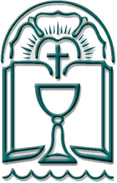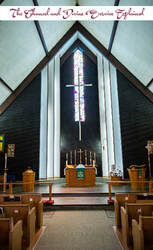What We Believe

- There is only one true God (John 17:3), the Triune God, one God in three persons, as is clear from the command of Jesus to baptize "in the name of the Father and of the Son and of the Holy Spirit" (Matthew 28:19).
- The Bible is the Word of God. We reject any thought that makes only part of Scripture of God's Word or that allows for the possibility of factual error in Scripture.
- Jesus, true God, begotten of the Father from eternity and also true man, born of the Virgin Mary, is the only Savior from sin, death and the power of the devil.
- A person is justified by faith without the deeds of the law (Romans 3:28).
- Faith in Jesus is a living force within the Christian that will produce works that are pleasing to God "Faith by itself, if it is not accompanied by action is dead" (James 2:17).
Our Worship Style
The Divine Service Tells the Story of Salvation
We are a “liturgical” church. That means that the basic pattern of our worship is drawn from the services that have been used by Christians for many centuries all across the world. The components of the Liturgy come from the Bible and serve to focus our worship on God’s Word and our response to His Word in faith.
In the Divine Service, God provides His service for us. In the reading, the preaching, and the proclamation of His Word, in His Sacraments of Holy Baptism and the Lord’s Supper, God comes to us. The work we do in worship is to be given the gift of God’s grace and respond. God initiates a holy conversation: He speaks first. Only then do His people respond, not the other way around. Such is the way God has worked from the very beginning of creation. God speaks into nothingness, emptiness–and then there is something to talk about!
The structure of the Divine Service is the story of God’s work of salvation–the essence of the Bible itself. The Gloria in Excelsis begins at the beginning–the Christmas announcement of the angels–but in the process makes of us messengers bringing the news of peace on earth, reminds us that the God we worship has come in the flesh, and points forward to the Lord’s Supper that will come later. The Kyrie joins us to those lepers, the blind, the deaf, the sick, and all those who call upon the Lord for mercy and gives us the hope that as they graciously received it, so will we as we meet Christ in this service. The Readings place us within the biblical narrative at a specific time and place to hear the Word alongside its original hearers, both believers and doubters, the obedient and the disobedient. The Agnus Dei puts us alongside John the Baptizer and once again enables us to ask for mercy. The Sanctus reminds us that the Christ who is acclaimed with the Palm Sunday crowd is none other than the Messiah whom Isaiah saw high and lifted up, the One we will meet in the flesh momentarily. The Words of Institution are the purest narrative, explaining, interpreting, and offering what we have asked for all along–Kyrie eleison, Lord have mercy. The Nunc Dimittis brings the worshiper full circle to where it all began and makes of us Simeons who have held the Lord in our hands and have thus seen the promise fulfilled. We are ready to go in peace.
We are a “liturgical” church. That means that the basic pattern of our worship is drawn from the services that have been used by Christians for many centuries all across the world. The components of the Liturgy come from the Bible and serve to focus our worship on God’s Word and our response to His Word in faith.
In the Divine Service, God provides His service for us. In the reading, the preaching, and the proclamation of His Word, in His Sacraments of Holy Baptism and the Lord’s Supper, God comes to us. The work we do in worship is to be given the gift of God’s grace and respond. God initiates a holy conversation: He speaks first. Only then do His people respond, not the other way around. Such is the way God has worked from the very beginning of creation. God speaks into nothingness, emptiness–and then there is something to talk about!
The structure of the Divine Service is the story of God’s work of salvation–the essence of the Bible itself. The Gloria in Excelsis begins at the beginning–the Christmas announcement of the angels–but in the process makes of us messengers bringing the news of peace on earth, reminds us that the God we worship has come in the flesh, and points forward to the Lord’s Supper that will come later. The Kyrie joins us to those lepers, the blind, the deaf, the sick, and all those who call upon the Lord for mercy and gives us the hope that as they graciously received it, so will we as we meet Christ in this service. The Readings place us within the biblical narrative at a specific time and place to hear the Word alongside its original hearers, both believers and doubters, the obedient and the disobedient. The Agnus Dei puts us alongside John the Baptizer and once again enables us to ask for mercy. The Sanctus reminds us that the Christ who is acclaimed with the Palm Sunday crowd is none other than the Messiah whom Isaiah saw high and lifted up, the One we will meet in the flesh momentarily. The Words of Institution are the purest narrative, explaining, interpreting, and offering what we have asked for all along–Kyrie eleison, Lord have mercy. The Nunc Dimittis brings the worshiper full circle to where it all began and makes of us Simeons who have held the Lord in our hands and have thus seen the promise fulfilled. We are ready to go in peace.
